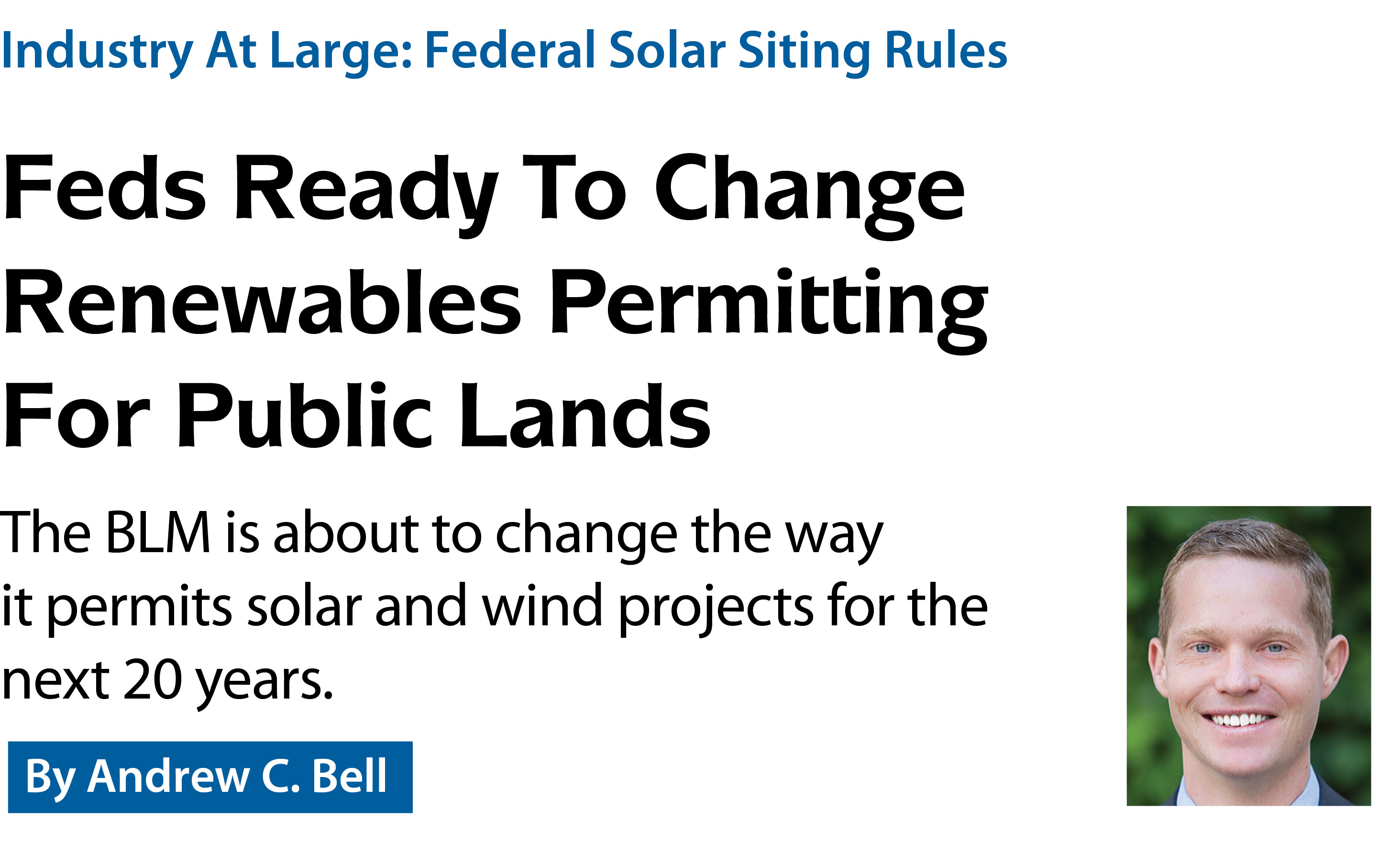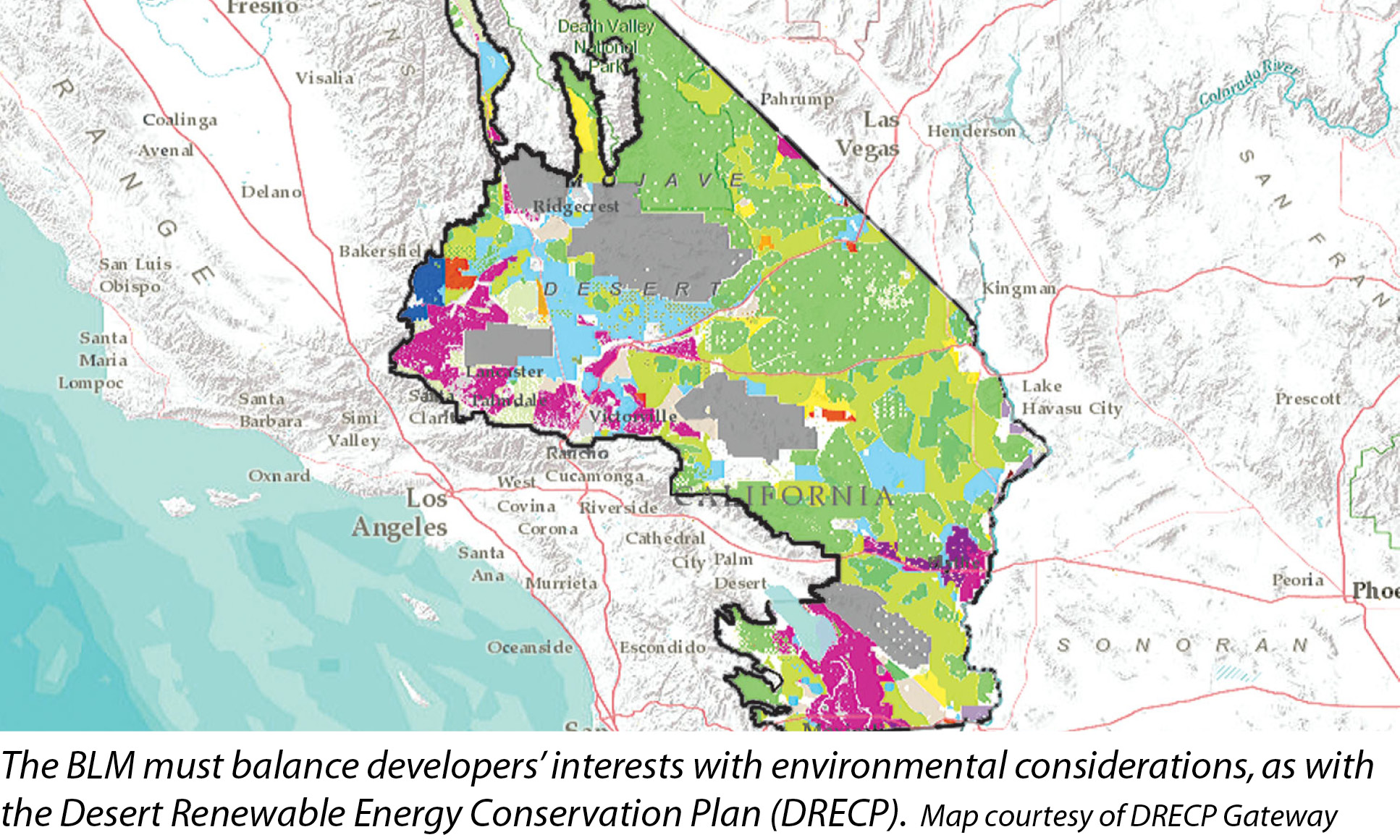

301 Moved Permanently
In September 2014, the U.S. Department of the Interior’s (DOI) Bureau of Land Management (BLM) published a proposed rule to amend its regulations governing solar and wind rights-of-way. The proposed rule would establish a framework of preferred “designated leasing areas” (DLAs) and competitive leasing procedures both inside and outside of the DLAs.
The BLM would codify bonding, rental, megawatt-capacity fee and pre-application policies established through a series of instruction memoranda issued in February 2011, with each policy containing more favorable terms for lands within a DLA. A final rule is expected later this year.
Although well intended, these wholesale changes are unlikely to simplify an already cumbersome BLM permitting process. After summarizing key aspects of the proposed rule, the following examines how they could be improved.
The proposed rule would build on the solar energy zone (SEZ) concept of the BLM’s 2012 Solar Energy Plan by creating a new DLA land use plan designation for areas identified as preferred locations for solar or wind energy development. DLAs would be created through the BLM’s land use planning process and attendant National Environmental Policy Act (NEPA) review.
All wind and solar rights-of-way issued within a DLA would be termed “leases” rather than “grants.” The BLM would identify new DLAs based on nominations and expressions of interest, on its own initiative, or both.
The BLM’s existing regulations allow competitive leasing only in instances where it receives two or more competing right-of-way applications over the same lands. The proposed rule would expand this mandate by allowing the BLM to include land in a competitive offer on its own initiative, even in the absence of competition, both inside and outside DLAs. Competitive leasing would be mandatory within DLAs and left to the discretion of the BLM outside DLAs.
Competitive leasing within DLAs would occur under more favorable terms than competitive leasing outside these areas. For example, a winning bidder outside a DLA would merely win the right to apply for a grant as the “preferred applicant,” but a winning bidder within a DLA would be offered an actual lease.
Competitive offers would also provide for variable offsets totaling as much as 20% of the bid, based on a variety of factors, such as evidence of a power purchase agreement (PPA) or a large generator interconnection agreement (LGIA); preferred wind or solar technologies; prior site testing; prior pending applications; timeliness of project development, financing and economic factors; and environmental or public benefits.
Right-of-way applications still could be filed outside DLAs and without a competitive process if no competition exists and the BLM decides not to include the lands in a competitive offer.
Under such conditions, the proposed rule would codify the BLM’s 2011 guidance by requiring two pre-application meetings before developers could submit a right-of-way application. The first meeting would focus on potential siting and environmental issues or concerns; the second meeting would include other federal, tribal, state and local agencies in a similar discussion.
The BLM’s 2011 high-, medium- and low-priority screening criteria also would be codified and applied during the pre-application process to either reject or accept and prioritize an application. Solar applicants would have to pay a nonrefundable application fee of $15 per acre ($2 per acre for wind projects).
The proposed rule would codify the BLM’s existing policy of charging rent on an acreage and capacity-fee basis for both DLA and non-DLA rights-of-way.
Although the capacity fee would be carried forward, the fee schedule for 2014-2018 would be approximately one-third less than the current schedule established in 2010, due to the substantial reduction in wholesale power prices since then.
Favorable rental terms would apply to projects within DLAs. The acreage rent would be adjusted every 10 years within a DLA and annually outside of a DLA. Within a DLA, project owners would pay 50% of the capacity fee for the first 10 years and 100% thereafter; outside of a DLA, the capacity fee would be phased in over three years at 25%, 50% and 100% - as opposed to 20% for each of five years under the current policy.
The BLM would continue to require bonding for solar and wind projects on the basis of its surface mining assurance regulations. However, DLA project bonding would be capped at $10,000 per acre for solar and $20,000 per turbine for wind. The same numbers would apply to non-DLA projects, but they would apply as minimums instead of maximums.
In addition to the direct transfer of interests, the proposed rule would require an approved assignment for change in ownership or other related change in control transactions, but it may only require a new demonstration of technical and financial capability if a grant or lease holder becomes a wholly owned subsidiary. The proposed rule also clarifies that pending applications are not assignable.
Right-of-way applications over lands that subsequently fall within a DLA would be exempt from the DLA competitive leasing process if the application was filed before publication of a notice of availability of the draft or the proposed land use amendment creating the DLA.

Implications for developers
The proposed rule would extensively revise the BLM’s solar and wind right-of-way regulations, but these changes are unlikely to streamline the permitting process.
Competitive leasing would impose an additional upfront cost for solar energy sites on public land. For example, the Dry Lake SEZ pilot competitive lease bid on June 30, 2014, generated an additional upfront charge of approximately $1,892 per acre.
Competitive leasing could also lengthen and complicate project siting. The BLM did, in fact, recently prepare environmental assessments (EAs) for the competitively bid Dry Lake SEZ projects in under six months, but the EAs were preceded by more than four years of NEPA review, which culminated in the October 2012 Solar Programmatic Environmental Impact Statement, followed by another 18 months of regional planning. Individual DLAs would require lengthy preparation as well, putting solar projects on hold in the interim.
Some question whether the competitive process itself is even appropriate in the solar context. Competitive bids are useful to establish a market value for a product that cannot otherwise be priced - such as oil and gas leasing - where the pre-lease market value of the resource is essentially unknown. Solar is different, however. There is nothing unknown about the value of the energy-generating resource at a given solar site.
If the BLM nonetheless adopts a competitive leasing framework, it should give developers greater certainty by simplifying the process. Minimum bids should be tied solely to a percentage of the annual rent value of the land. Bidding should be limited to the rental price paid per acre for the fixed term of the grant or lease. Competitive bidding outside DLAs should only occur in the presence of competition, if at all, rather than at the discretion of the BLM.
The variable offset concept should be abandoned because most of the offset factors are either unworkable - PPAs, LGIAs and site testing usually require prior site control - or are so subjective as to invite gamesmanship and legal challenge, such as what constitutes public and environmental “benefits” or “preferred” technologies.
And, rather than putting the non-DLA lands at a disadvantage through arbitrary phasing, bonding and other distinctions, the BLM should propose more direct DLA incentives, such as reduced rents, lower mitigation costs through regional planning and front-loaded Endangered Species Act Section 7 reviews.
Outside the competitive context, the pre-application process merely duplicates existing BLM regulatory procedures at the risk of making uninformed decisions due to a lack of prior NEPA review. Indeed, by rejecting applications prior to the initiation of the NEPA review, the pre-application process inadvertently creates the presumption that the BLM will approve any project that begins the NEPA review; yet that is precisely the kind of behavior NEPA was designed to prevent.
If the pre-application process is carried forward, however, regulations should provide for strict, enforceable time limits - 90 days, for example. They should also clearly confer site control from application acceptance until the application is withdrawn, rejected or matures into a grant.
Finally, although the BLM has the authority to charge land rent, it is unclear whether it has the authority to charge a megawatt-capacity fee. Because the federal government lacks an ownership interest in sunlight or the wind, it cannot sell the right to use such renewable resources for profit (unlike the sale of federal minerals), charge a royalty against the sale proceeds (unlike federal oil and gas rights) or charge rent for the use of sunlight (unlike federal land-surface-occupancy rights).
Nor is the capacity fee a regulatory fee: It bears no relation to services rendered by the BLM and is paid to the U.S. Treasury instead of to a BLM cost recovery account. If anything, the capacity fee resembles a tax for contribution to a general fund spent for the benefit of the U.S. public. The DOI lacks the power to tax, however.
The BLM’s right-of-way regulations have always been an awkward framework for the permitting of non-linear facilities, such as solar and wind projects. The proposed rule seeks to remedy this problem by creating new regulations specific to solar and wind energy projects. But the work is only half done. The regulations (and resulting process) must also be clear and simple if the BLM is to avail itself of an extraordinary opportunity to substantially reduce this country’s greenhouse-gas emissions through a single, streamlined renewable energy permitting process over the 245 million acres it manages. S
Industry At Large: Federal Solar Siting Rules
Feds Ready To Change Renewables Permitting For Public Lands
By Andrew C. Bell
The BLM is about to change the way it permits solar and wind projects for the next 20 years.
si body si body i si body bi si body b
si depbio
- si bullets
si sh
si subhead
pullquote
si first graph
si sh no rule
si last graph